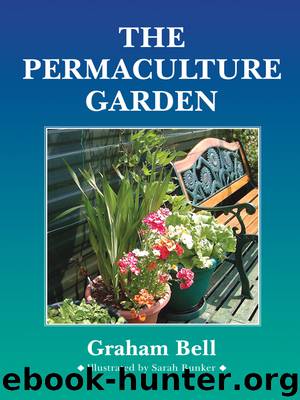The Permaculture Garden by Graham Bell

Author:Graham Bell
Language: eng
Format: epub
Tags: ebook, book
Publisher: Chelsea Green Publishing
Published: 2011-02-26T16:00:00+00:00
Raised beds offer greater growing area, more choice of micro-climate, and are more interesting to look at than growing on the flat.
A favourite amongst no-dig gardeners is the straight raised bed. This gives the advantage of increased growing area (one and a half times that of a 'flat' bed) which is achieved by raised beds generally, but means that we can produce crops in small blocks of varieties to be harvested seasonally. For this reason it is often used by commercial organic vegetable producers.
Mark the area to be made with a line. Make the bed by double digging. Take off the turf and topsoil from the first metre and barrow to the far end of the bed. Dig the second spade's depth of topsoil, cover this with inverted turf from the next metre section of the bed and then with the underlying topsoil. In cross section the bed should be heaped. Carry on until the end of the bed is reached and then cover over the last metre of subsoil with the turf and topsoil from the barrow, brought from the far end.
Some slight raising is achieved by digging; additional organic material placed around the inverted turf layer will raise it further. Digging out surrounding pathways can be particularly helpful. This creates a core to the bed which offers a long-term nitrogen release. When the bed is complete, maintain it by mowing the grass paths alongside, keeping the edges clipped, and by digging a gutter along each edge. Fine soil will accumulate in this small trench as a result of run off from the slope, and as birds feed amongst the plants. Continuous mulching between the plants will help this process, which develops a rich humic layer which is dug and spread back on the surface of the bed.
The gutter effect means that rain infiltrates to root level very quickly, so that evaporation is minimized and plants quickly get the benefit of any rain in dry periods. It also means that in heavy rainfall run-off of both water and topsoil is trapped and kept in the bed where it is needed. If the beds are run in an east-west direction, then they have a sunny and a shady side. Plants can either be planted to take advantage of their preference for differing levels of heat, or taller plants can be planted on the shade side so as not to shade out smaller plants which occupy the sun side.
Raised beds should be no wider than can be easily reached to the mid-point, so that it is never necessary to walk on them, giving maximum soil life and minimum compaction.
A simpler method of raised beds used by many organic gardeners is to edge the beds with old boards secured upright with stakes. Inevitably this gives rectangular beds. It shares the advantages of deepening topsoil and keeping beds free from compaction, whilst meeting a certain standard of 'neatness'. The soil will cool more quickly in the autumn/winter and warm more quickly in the summer because the bed is raised up into the air.
Download
This site does not store any files on its server. We only index and link to content provided by other sites. Please contact the content providers to delete copyright contents if any and email us, we'll remove relevant links or contents immediately.
| Colder Climates | Desert |
| Temperate | Tropical |
Turbulence by E. J. Noyes(7039)
The Thirst by Nesbo Jo(5785)
Gerald's Game by Stephen King(3918)
Be in a Treehouse by Pete Nelson(3212)
Marijuana Grower's Handbook by Ed Rosenthal(3119)
The Sprouting Book by Ann Wigmore(3052)
The Red Files by Lee Winter(2914)
The Remains of the Day by Kazuo Ishiguro(2618)
Sharp Objects: A Novel by Gillian Flynn(2445)
Christian (The Protectors Book 1) by L. Ann Marie(2394)
Organic Mushroom Farming and Mycoremediation by Tradd Cotter(2307)
The Culinary Herbal by Susan Belsinger(2061)
Stone Building by Kevin Gardner(1995)
The Starter Garden Handbook by Alice Mary Alvrez(1925)
Lilac Girls by Martha Hall Kelly(1875)
The Unlikely Pilgrimage of Harold Fry by Rachel Joyce(1836)
The Lean Farm Guide to Growing Vegetables: More In-Depth Lean Techniques for Efficient Organic Production by Ben Hartman(1784)
Urban Farming by Thomas Fox(1749)
Backyard Woodland by Josh VanBrakle(1587)
